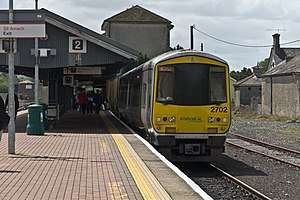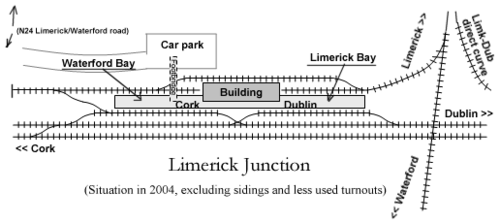Limerick Junction railway station
Limerick Junction (Irish: Gabhal Luimnigh) is the interchange railway station for trains originating in Limerick, Dublin Heuston, Cork, Waterford, Tralee and Ennis stations.[1] The station opened on 3 July 1848.[2]
 A train at Limerick Junction | ||||||||||||||||||||||||||||
| Location | Limerick Junction, County Tipperary, E34 E984 Republic of Ireland | |||||||||||||||||||||||||||
| Coordinates | 52°29′58″N 8°12′04″W | |||||||||||||||||||||||||||
| Owned by | Iarnród Éireann | |||||||||||||||||||||||||||
| Operated by | Iarnród Éireann | |||||||||||||||||||||||||||
| Platforms | 4 | |||||||||||||||||||||||||||
| Construction | ||||||||||||||||||||||||||||
| Structure type | At-grade | |||||||||||||||||||||||||||
| Other information | ||||||||||||||||||||||||||||
| Station code | LMRKJ | |||||||||||||||||||||||||||
| Fare zone | N | |||||||||||||||||||||||||||
| Key dates | ||||||||||||||||||||||||||||
| 1848 | Station opened | |||||||||||||||||||||||||||
| 2007 | Number of platforms reduced to three | |||||||||||||||||||||||||||
| 2011 | Signalling upgraded to CTC | |||||||||||||||||||||||||||
| 2019 | New platform opened | |||||||||||||||||||||||||||
| ||||||||||||||||||||||||||||
Dublin to Cork | |||||||||||||||||||||||||||||||||||||||||||||||||||||||||||||||||||||||||||||||||||||||||||||||||||||||||||||||||||||||||||||||||||||||||||||||||||||||||||||||||||||||||||||||||||||||||||||||||||||||||||||||||||||||||||||||||||||||||||||||||||||||||||||||||||||||||||||||||||||||||||||||||||||||||||||||||||||||||||||||||||||||||||||||||||||||||||||||||||||||||||||||||||
|---|---|---|---|---|---|---|---|---|---|---|---|---|---|---|---|---|---|---|---|---|---|---|---|---|---|---|---|---|---|---|---|---|---|---|---|---|---|---|---|---|---|---|---|---|---|---|---|---|---|---|---|---|---|---|---|---|---|---|---|---|---|---|---|---|---|---|---|---|---|---|---|---|---|---|---|---|---|---|---|---|---|---|---|---|---|---|---|---|---|---|---|---|---|---|---|---|---|---|---|---|---|---|---|---|---|---|---|---|---|---|---|---|---|---|---|---|---|---|---|---|---|---|---|---|---|---|---|---|---|---|---|---|---|---|---|---|---|---|---|---|---|---|---|---|---|---|---|---|---|---|---|---|---|---|---|---|---|---|---|---|---|---|---|---|---|---|---|---|---|---|---|---|---|---|---|---|---|---|---|---|---|---|---|---|---|---|---|---|---|---|---|---|---|---|---|---|---|---|---|---|---|---|---|---|---|---|---|---|---|---|---|---|---|---|---|---|---|---|---|---|---|---|---|---|---|---|---|---|---|---|---|---|---|---|---|---|---|---|---|---|---|---|---|---|---|---|---|---|---|---|---|---|---|---|---|---|---|---|---|---|---|---|---|---|---|---|---|---|---|---|---|---|---|---|---|---|---|---|---|---|---|---|---|---|---|---|---|---|---|---|---|---|---|---|---|---|---|---|---|---|---|---|---|---|---|---|---|---|---|---|---|---|---|---|---|---|---|---|---|---|---|---|---|---|---|---|---|---|---|---|---|---|---|---|---|---|---|---|---|---|---|---|---|---|---|---|---|---|---|---|---|---|---|---|---|---|---|---|---|---|---|---|---|---|---|---|---|---|---|---|---|
| |||||||||||||||||||||||||||||||||||||||||||||||||||||||||||||||||||||||||||||||||||||||||||||||||||||||||||||||||||||||||||||||||||||||||||||||||||||||||||||||||||||||||||||||||||||||||||||||||||||||||||||||||||||||||||||||||||||||||||||||||||||||||||||||||||||||||||||||||||||||||||||||||||||||||||||||||||||||||||||||||||||||||||||||||||||||||||||||||||||||||||||||||||
Limerick–Rosslare | |||||||||||||||||||||||||||||||||||||||||||||||||||||||||||||||||||||||||||||||||||||||||||||||||||||||||||||||||||||||||||||||||||||||||||||||||||||||||||||||||||||||||||||||||||||||||||||||||||||||||||||||||||||||||||||||||||||||||||||||||||||||||||||||||||||||||||||||||||||||||||||||||
|---|---|---|---|---|---|---|---|---|---|---|---|---|---|---|---|---|---|---|---|---|---|---|---|---|---|---|---|---|---|---|---|---|---|---|---|---|---|---|---|---|---|---|---|---|---|---|---|---|---|---|---|---|---|---|---|---|---|---|---|---|---|---|---|---|---|---|---|---|---|---|---|---|---|---|---|---|---|---|---|---|---|---|---|---|---|---|---|---|---|---|---|---|---|---|---|---|---|---|---|---|---|---|---|---|---|---|---|---|---|---|---|---|---|---|---|---|---|---|---|---|---|---|---|---|---|---|---|---|---|---|---|---|---|---|---|---|---|---|---|---|---|---|---|---|---|---|---|---|---|---|---|---|---|---|---|---|---|---|---|---|---|---|---|---|---|---|---|---|---|---|---|---|---|---|---|---|---|---|---|---|---|---|---|---|---|---|---|---|---|---|---|---|---|---|---|---|---|---|---|---|---|---|---|---|---|---|---|---|---|---|---|---|---|---|---|---|---|---|---|---|---|---|---|---|---|---|---|---|---|---|---|---|---|---|---|---|---|---|---|---|---|---|---|---|---|---|---|---|---|---|---|---|---|---|---|---|---|---|---|---|---|---|---|---|---|---|---|---|---|---|---|---|---|---|---|---|---|---|---|---|---|---|---|---|---|---|---|---|---|
| |||||||||||||||||||||||||||||||||||||||||||||||||||||||||||||||||||||||||||||||||||||||||||||||||||||||||||||||||||||||||||||||||||||||||||||||||||||||||||||||||||||||||||||||||||||||||||||||||||||||||||||||||||||||||||||||||||||||||||||||||||||||||||||||||||||||||||||||||||||||||||||||||
Location
It is located in County Tipperary, Ireland and was originally named "Tipperary Junction".
Tipperary town is about 2 miles (3 km) away to the south-east.
Limerick Junction, with a cluster of railway cottages and a pub, is a small hamlet.
The station serves Tipperary Racecourse.
Services
There are 48 trains on a weekday to 6 destinations: 17 trains to Dublin Heuston, 13 to Cork, 2 to Waterford, 11 to Limerick, 3 to Ennis and 2 to Galway.
There is an hourly train to Limerick, with some services extended to Ennis or Galway. Most trains operating between Dublin and Cork or vice versa stop here.
Bus Connection
Local Link
Local Link bus stops at Limerick Junction Railway Station.
Timetable is 855 – (T41) Tipperary Town to Cashel via Cahir & Limerick Junction Timetable [3]
Layout
Because of its complex layout it has a special place in railway lore: it is the only remaining railway junction in Ireland where two lines cross at a near-90-degree angle. One route is the Dublin-Cork main line, while the other is the line from Limerick to Waterford. Trains from all four locations are served, some connecting to Ennis in County Clare and Tralee in County Kerry.
The layout consists of four platforms, all of which are in use. The main line platform, number 1, is a through platform. The terminal platform, to the west of Platform 1, is numbered 2 for part of its length and 3 for the rest, to distinguish between the two trains that may be there in the event of a Waterford train and a Limerick train being present at once. Access to Platforms 2 and 3 for trains from anywhere other than Limerick requires reversing. A train coming from Waterford must cross the Dublin-Cork main line towards Limerick, reversing along the curve used by trains arriving from Limerick. It can then stop at the Limerick bay. The cumbersome procedure of trains to Waterford passing the station before reversing into the former Platform 4 was ended in 2007 and trains to Waterford as well as trains to Limerick depart from Platforms 2 and 3. Other places in the Ireland that required some or all trains to reverse include:
History
Until the 1960s trains on the main Dublin-Cork line, in both directions, also needed to reverse into the platforms if they were calling at the station (as almost all did); the main lines passing one or two tracks away from the platform and the points being arranged that trains in both directions needed to stop on the main line and then reverse over points into the platform. The tracks were rearranged in the mid-1960s to overcome this. What had always perplexed (and made Limerick Junction a centre of attention similar to the interest shown in the Listowel and Ballybunion monorail) is that there was always sufficient space for additional platforms, even to construct a "separate" (but linked) station on the Limerick to Waterford line, and certainly (as events proved) track alteration was feasible; the arrangement therefore seemed eccentric - certainly when main line trains between Cork and Dublin were required to reverse.
In 1967 a short curve was constructed just north of Limerick Junction allowing through main line trains between Limerick and Dublin without reversal at Ballybrophy or single (perhaps double) reversal around Limerick Junction itself. Trains using the direct curve cannot stop at Limerick Junction. The curve is only used by three trains each way per day since the most recent timetable changes in December 2009. Through running (without reversal) from Limerick to Mallow and Cork is possible.
A new platform 4 became operational on 25 August 2019.[4] Associated works included a new 20 metre span footbridge, passenger shelters and seating and new lighting.[5] The platform, measuring 260 metres, has removed the constraints and speed restrictions associated with the former single platform which catered for all Dublin to Cork/Kerry services in both directions.[6] Improved journey times of up to five minutes for Dublin to Cork/Kerry services, and of up to 11 minutes for Limerick to Cork/Dublin services due to improved connections will be delivered over time, the company hopes.[6] A new footbridge with high capacity lifts was also built, catering for customers transferring to the new platform. The investment was worth €3.5m to the station.[6] The planning application for the new platform and associated works was submitted to Tipperary County Council in April 2018, with planning permission granted in June 2018.[7] Works were completed both between trains and during railway possessions.[5].
Old layout

The station at Limerick Junction is surrounded by track. Trains accessing the Waterford bay from Limerick or Waterford must reverse into the platform. Trains from Waterford also reverse back from "Keane's points", where the curve out from the station joins the line. The track layout here has been reduced to now only two platforms. The bay platform to the north is used for trains to Limerick and Waterford/Rosslare and the main line platform is used for Dublin to Cork trains. The Waterford bay, which was located at the south end of the station, is now lifted and the so has the line that ran behind the station. The scissor crossover which is located halfway down the mainline platform is due to be lifted and the south loop of the mainline has now been disconnected. The Cork half of the through platform has also been removed and the area used to extend the car park.
Horse racing
Limerick Junction was also the name of the racecourse at the same location. In 1986 it was renamed Tipperary Racecourse. The course is not conducive to winter racing because of the frequency of water-logging. Racing here is a major attraction during the summer months and large crowds are attracted to the venue, especially for the Thursday evening meetings.
See also
References
- "Archived copy". Archived from the original on 20 July 2012. Retrieved 31 July 2012.CS1 maint: archived copy as title (link)
- "Limerick Junction" (PDF). Railscot - Irish Railways. Retrieved 7 September 2007.
- "855 – (T41) Tipperary Town to Cashel via Cahir & Limerick Junction Timetable" (PDF). Retrieved 2 March 2020.
- "departure time changes from Sun 25th August". wwww.irishrail.ie. Retrieved 23 August 2019.
- "News Stories". Theglobalinfrastructuregroup.com. 10 May 2016. Retrieved 29 April 2019.
- "New platform planned at Limerick Junction to keep time improvements on track". Limerickleader.ie. Retrieved 29 April 2019.
- Hyland, Alison (20 June 2018). "Limerick Junction station is set for a major revamp". Tippfm.com. Retrieved 29 April 2019.
External links
| Wikimedia Commons has media related to Limerick Junction railway station. |